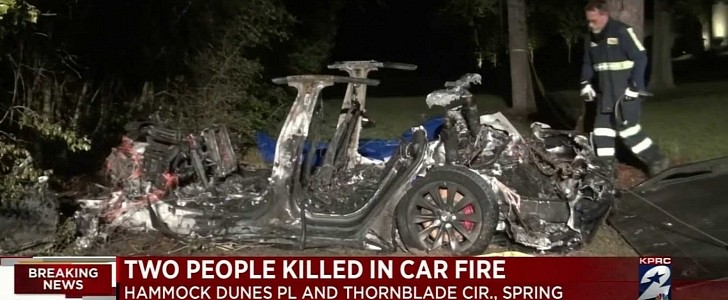When William Varner, 59, and Everette Talbot, 69, died in a fiery crash in Texas back on April 17, 2021, weird details started to emerge. The first responders said no one was at the driver’s seat of the Tesla Model S, which was confirmed by where the bodies were found: one in the front passenger seat and another in the second row. That led investigators to suspect Autopilot could have been involved. Now Bloomberg added another piece to this puzzle with the autopsy report: both men had alcohol blood levels above the legal limits.
According to the report obtained by Bloomberg, Varner’s body had 0.151 g of ethanol per 100 ml of blood. Talbot had 0.075 g/100 ml. In Texas, the legal limit is 0.08 g/100 ml. The report also stated how the two men died: blunt-force trauma and thermal injuries. Varner would also have been intoxicated by smoke inhalation.
What we know so far about the crash is that Varner got into his car with Talbot on the passenger seat right after they returned from dinner, something that his home’s security camera proves. According to their wives, they were talking about the car and its “self-driving ability” when they departed.
Soon after that, the car was driving “at a high rate of speed.” The Model S then drifted off the road, “struck a raised curb, entered a grassy area, traveled about 100 feet“ (30.5 meters), hit a tree, and caught fire. Varner’s body was found on the left side of the rear seat.
Lars Moravy, Tesla’s vice president for vehicle engineering, said at the time that TACC – not Autopilot – was engaged when the driver buckled up and was at more than 5 mph, accelerating the vehicle to 30 mph. It then would have disengaged when the driver unbuckled the seat belt. The deformed steering wheel would prove that the driver was in the car when it crashed, according to Moravy.
If that was really the case, Varner could have moved to the rear seat to try to escape the car. When the 12V system in a Tesla fails, the doors have to be opened through a manual release. Ironically, the Model S front doors would have mechanical releases: you would just need to keep pulling the handles further than you usually do: that would engage a cable and open the doors. We wonder if Varner knew that. The process is not that intuitive in the back: a latch under the seats releases the doors.
The investigations are still ongoing. Hopefully, they may reveal which hypothesis is the right one. Either Varner was in the rear seat trying to prove his car had “self-driving ability” – which no vehicle currently for sale has – or he was just trying to escape after he couldn’t open the driver’s door. Other security cameras and more evidence may help us discovered what really happened that night.
What we know so far about the crash is that Varner got into his car with Talbot on the passenger seat right after they returned from dinner, something that his home’s security camera proves. According to their wives, they were talking about the car and its “self-driving ability” when they departed.
Soon after that, the car was driving “at a high rate of speed.” The Model S then drifted off the road, “struck a raised curb, entered a grassy area, traveled about 100 feet“ (30.5 meters), hit a tree, and caught fire. Varner’s body was found on the left side of the rear seat.
Lars Moravy, Tesla’s vice president for vehicle engineering, said at the time that TACC – not Autopilot – was engaged when the driver buckled up and was at more than 5 mph, accelerating the vehicle to 30 mph. It then would have disengaged when the driver unbuckled the seat belt. The deformed steering wheel would prove that the driver was in the car when it crashed, according to Moravy.
If that was really the case, Varner could have moved to the rear seat to try to escape the car. When the 12V system in a Tesla fails, the doors have to be opened through a manual release. Ironically, the Model S front doors would have mechanical releases: you would just need to keep pulling the handles further than you usually do: that would engage a cable and open the doors. We wonder if Varner knew that. The process is not that intuitive in the back: a latch under the seats releases the doors.
The investigations are still ongoing. Hopefully, they may reveal which hypothesis is the right one. Either Varner was in the rear seat trying to prove his car had “self-driving ability” – which no vehicle currently for sale has – or he was just trying to escape after he couldn’t open the driver’s door. Other security cameras and more evidence may help us discovered what really happened that night.






